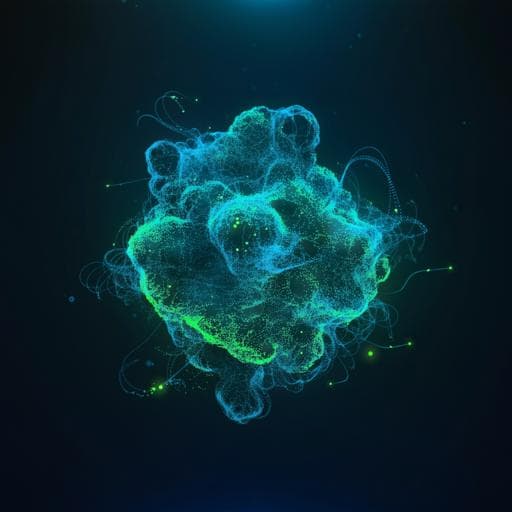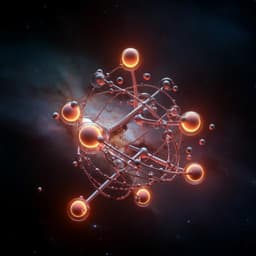
Engineering and Technology
Materials property mapping from atomic scale imaging via machine learning based sub-pixel processing
J. Han, K. Go, et al.
Discover a groundbreaking machine learning-based method by Junghun Han, Kyoung-June Go, Jinhyuk Jang, Sejung Yang, and Si-Young Choi for enhancing the accuracy of material property mapping from atomic-scale STEM images. This innovative approach combines advanced segmentation, denoising processes, and clustering techniques to achieve sub-pixel precision.
~3 min • Beginner • English
Introduction
Advances in aberration-corrected STEM now enable sub-Å beam probes and atomic-scale imaging, motivating quantitative extraction of atomic positions to analyze strain, polarization, and octahedral tilts. Because many structural transitions manifest as picometer-scale shifts, precisely locating atomic columns from single noisy STEM images is critical. Multi-image registration can boost SNR but increases dose and risks specimen alteration, so robust single-image enhancement and analysis are preferred. Conventional frequency-domain filters and denoising (e.g., Wiener, PCA, non-local means, BM3D) mainly target Gaussian noise, whereas STEM images are dominated by Poisson statistics. For position determination, model-based fitting (2D quadratic or Gaussian) can achieve high precision but at increased computational cost and potential bias if the peak shape deviates from the model. Center-of-mass (CoM) methods are fast and can be sub-pixel accurate, but are sensitive to background contamination due to coarse region selection. This work addresses these gaps by developing PRESTem, a pipeline that enhances single images, segments atomic columns from background via unsupervised clustering, and then applies CoM to achieve sub-pixel localization with low computation, enabling picometer-scale structural mapping.
Literature Review
Prior efforts to enhance single STEM images used frequency-domain filters exploiting lattice periodicity (e.g., optimized Wiener and band-pass filters) and advanced denoisers (PCA, non-local means, BM3D). These approaches are generally optimized for Gaussian noise and are less effective for the Poisson-dominated noise in STEM. For localization, model-based estimation using 2D quadratic and Gaussian fits has been widely used and refined, but with higher computational burden and possible mismatch when peaks are non-Gaussian. The CoM approach, common in particle tracking, is computationally efficient and potentially precise, but typically suffers from background inclusion due to approximate region selection. Existing toolchains combine various denoising and fitting strategies: PPA uses inverse Fourier filtering and 2D quadratic fits; CalAtom emphasizes intensity of heavy elements and applies Gaussian filtering with multiple-ellipse fitting; Atomap performs 1D PCA denoising followed by iterative CoM and 2D Gaussian fitting for each species. These tools offer different trade-offs between accuracy, bias, and computational cost, motivating a systematic comparison against the proposed method.
Methodology
The PRESTem pipeline comprises two main stages: pre-processing (noise reduction and contrast enhancement) and segmentation-based localization, applied to paired HAADF and ABF STEM images to capture heavy and light elements, respectively.
- Noise modeling and estimation: STEM noise is modeled as mixed Poisson–Gaussian. A patch-wise noise estimation procedure fits local noise statistics to obtain variance components across the image, confirming Poisson noise dominance in experimental HAADF-STEM (Gaussian σ ≈ 0–13.54; Poisson σ ≈ 41.70–67.63).
- Variance stabilization and denoising: The Anscombe transform is applied to stabilize Poisson variance, effectively converting it to approximately Gaussian noise. BM3D denoising is then used: similar patches are grouped via block matching (L2 distance), stacked into 3D arrays, transformed to a sparse domain, and denoised first by hard-thresholding, followed by a second grouping/denoising stage using Wiener filtering on the initially denoised estimate. Aggregation reconstructs the denoised image.
- Background correction and contrast enhancement: Residual background bias and stains are removed by morphological opening (erosion followed by dilation) to estimate the background trend, which is subtracted from the denoised image. Histogram stretching is then applied to emphasize atomic peaks relative to the background.
- Segmentation and localization: K-means clustering (unsupervised, with k set to separate atoms from background) binarizes the image into atomic columns and background. For each connected atomic region, the center of mass (CoM) of the binarized pixels defines the atomic position, yielding sub-pixel coordinates without assuming a specific peak shape. Heavy-atom coordinates are first extracted from HAADF; light-atom sites are then obtained from ABF after removing positions already assigned in HAADF. Unit-cell information provided by the user enables species classification and automated structural analysis (e.g., displacements, lattice parameters).
- Simulations for evaluation: HAADF-STEM images of SrTiO3 (and superlattices) were simulated via multislice (Dr. Probe) with pixel sampling 6.6 pm/px, 5 nm thickness, 200 kV, convergence semi-angle 25 mrad, detector 70–200 mrad, and zero aberrations/defocus. Controlled Poisson–Gaussian noise (e.g., σ_P=40, σ_G=10) and 10% background were added for benchmarking and sensitivity analyses.
Key Findings
- Denoising performance: The combined Anscombe+BM3D+morphological filtering yields visually consistent denoising across noise levels and improves PSNR by approximately 8–12 dB over the noisy input, outperforming BM3D-only, radial Wiener, and Gaussian filtering, particularly by removing residual background content.
- Localization precision vs. noise: Despite increasing input Poisson noise, the method maintains sub-pixel localization precision; accuracy degrades gracefully with noise while PSNR remains relatively stable after denoising.
- Benchmarking vs. existing tools (σ_P=40, σ_G=10):
• PRESTem (K-means + CoM): average error 0.71 px, SD 0.51 px, errors normally distributed around zero (no bias). At 6.6 pm/px, 0.7 px ≈ 4.6 pm.
• PPA (9-point 2D quadratic fit): average error 1.88 px, SD 1.17 px.
• CalAtom (Gaussian filter + multiple-ellipse fitting): average error 1.82 px, SD 1.54 px.
• Atomap (1D PCA + iterative 2D elliptical Gaussian fitting): average error 0.83 px, SD 0.35 px; comparable to PRESTem but with y-axis bias and 10–100× higher computation time.
- Structural quantification accuracy:
• Ti off-centering in a SrTiO3 polar vortex test: average error 1.57 pm and 4.25° (SD 1.13 pm and 3.07°) across 256 unit cells; trend in displacement angle preserved.
• c/a ratio in (SrTiO3)10/(PbTiO3)10 superlattice: evaluated PbTiO3 c/a ≈ 1.00–1.05, matching ground truth; standard deviation 0.014 in SrTiO3 vs 0.004 in PbTiO3 (affected by Z-contrast differences).
- Practical aspects: Using segmentation to define CoM regions avoids background contamination, enabling a fast, model-free, sub-pixel approach competitive with Gaussian fitting but with lower computational cost and reduced bias.
Discussion
The study addresses the need for picometer-accurate atomic position extraction from single STEM images by combining variance-stabilized denoising and unsupervised segmentation with a fast CoM localizer. By explicitly modeling and suppressing Poisson-dominated noise (Anscombe+BM3D) and removing residual background via morphological filtering, the pipeline enhances atomic contrast without imposing a specific peak shape. K-means segmentation delineates atomic regions objectively, allowing CoM to operate on clean, binarized peaks and thereby avoid biases introduced by approximate fitting windows or mismatched model functions. Benchmarks demonstrate that this strategy achieves unbiased, sub-pixel precision comparable to or better than widely used model-based tools, with substantially lower computational overhead, and remains robust under severe noise. The dual-image workflow (HAADF for heavy atoms, ABF for light atoms) further broadens applicability across species. The accurate recovery of Ti displacements and c/a variations shows that the method reliably translates coordinate precision into meaningful local structural descriptors, supporting structure–property studies in complex oxides.
Conclusion
The authors present PRESTem, an automated pipeline for atomic-scale STEM analysis that integrates Anscombe+BM3D denoising, morphological background correction, histogram stretching, K-means segmentation, and CoM localization. This approach achieves unbiased, sub-pixel (few-picometer) precision in single images, improves PSNR by ~8–12 dB versus noisy inputs, and delivers structural metrics (e.g., displacements, c/a ratios) consistent with ground truth. Compared to established tools using model-based fits, PRESTem is competitive in accuracy while being faster and less prone to bias. The methodology generalizes beyond perovskites and can facilitate high-throughput, statistically robust studies by bridging rapid STEM acquisition with precise automated analysis. Future work may extend structural quantification beyond perovskites, integrate more species-specific segmentation for complex chemistries, and further optimize computational efficiency for very large datasets.
Limitations
Related Publications
Explore these studies to deepen your understanding of the subject.







